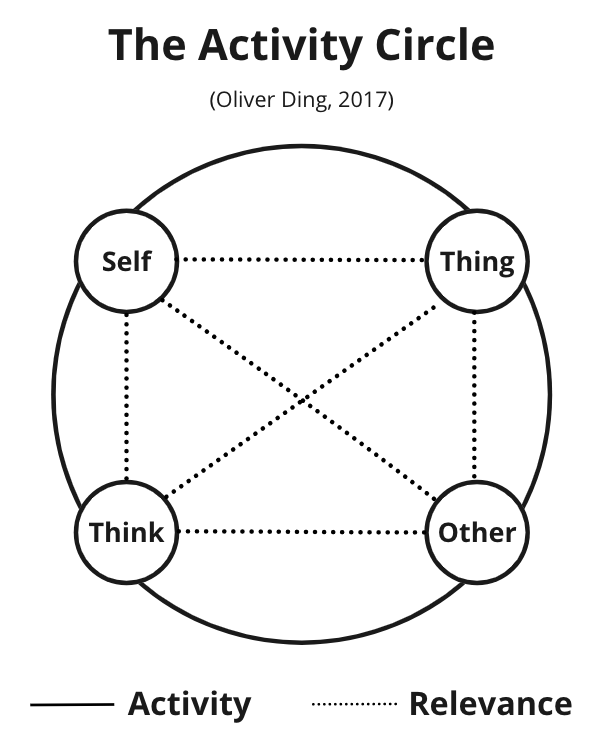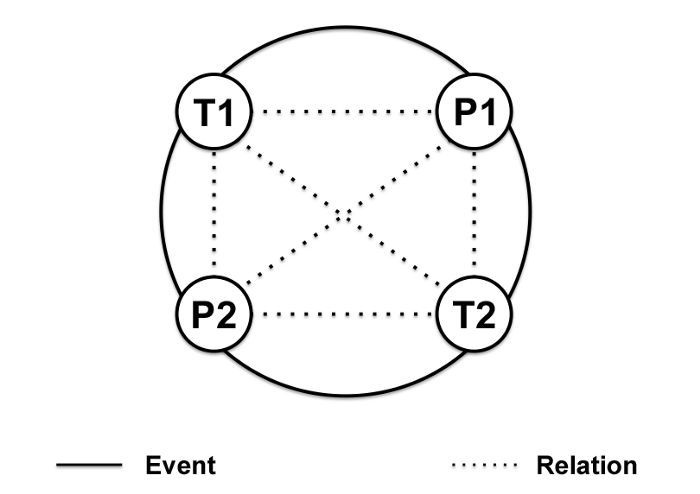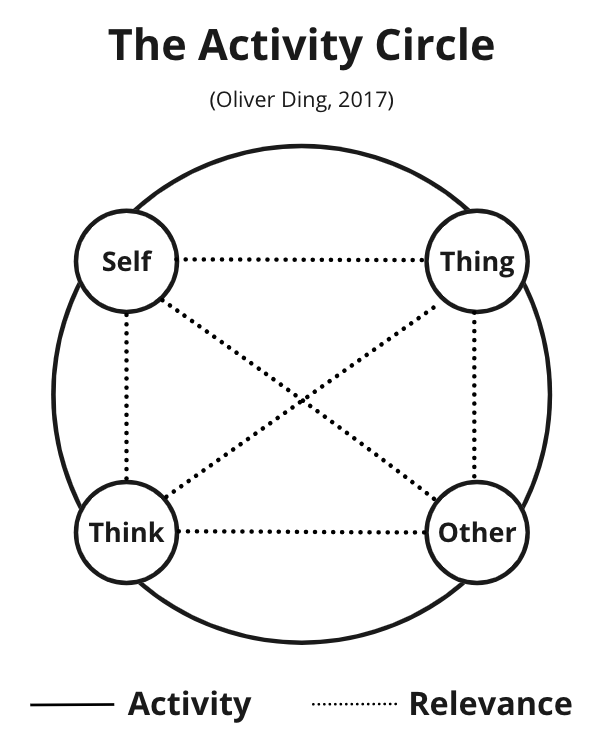The Activity Circle (Oliver Ding, 2017)

The Activity Circle focuses on “Self, Other, Thing, and Think”. It is perfect for discussing a special object which has double properties: material property and mental property. This idea was inspired by cultural-historical psychologist Lev Vygotsky’s two types of mediating tools: technological tools and psychological tools.
The original idea of the Activity Circle is called the "Activity - Relationship" perspective which was developed in 2017.
In 2021, I used it to connect Activity Theory with Relevance Theory. The model was named The Relevance of Zone.
In 2022, I rediscovered it with several new triggers and decided to rename it Activity Circle.
The Activity Circle is a new diagram and an abstract model. You have to turn it into a concrete model for your projects. This article shares some stories of using the model.

Benny Karpatschof on Human Activity
Several months ago, I found Benny Karpatschof’s 2000 book Human Activity: Contributions to the Anthropological Sciences from a Perspective of Activity Theory. Though I have read many books and papers about Activity Theory, Karpatschof’s theoretical approach opened a new door for me. The most important idea of his account is to bring Sign/Meaning/Concept back to Activity Theory.

According to Benny Karpatschof, “…the full context of activity in which the category of meaning (“ideas”) is situated can be seen. In the feedback circle, there is an operational as well as a referential mediation. I call the referential side meaning production. The other side is the category of object production, where production is to be understood in a broad sense, including interventions that only modified the object. If we now consider the relation between meaning and object production in human activity, there are 3 logical types: 1. The object-reflecting meaning production, 2. The symmetric interplay of objects and meaning production, 3. The concept based object production. ”(2000, p.248)
Benny Karpatchof’s approach to human activity considers both Tool and Sign. This approach echoes Lev Vygotsky’s two types of mediating tools. This is the reason that I pay attention to Benny Karoatchof’s 2000 book.
The difference between Benny Karpatschof’s model of Human Activity and my model of Activity Circle is the former only talks about the individual—object interaction and the latter considers the self—other relevance.
The Self - Relevance Relevance is part of the AAS framework. However, the AAS framework is only about "Present, Future". I need a model to discuss material/meaning in general.
Activity as Container
In fact, the Activity Circle was developed in 2017. It was the outcome of my project “Activity as Container” which aims to discuss “Activity as social environment”. Later, I used the Activity Circle diagram to generate a meta-diagram for discussing the Thing-People ecological structure. See the diagram below.

The above diagram is the final model of the Thing-People ecological structure. T means Thing while P means People. 1 means Here while 2 means There. The circle means one event.
I also use another version for this diagram: This (T1), That (T2), Self (P1), Other (P2), and Activity (Event). This version is close to the iART framework.
The Activity Circle uses Thing (T1), Think (T2), Self (P1), Other (P2), and Activity (Event).
These models share the same meta-diagram which presents six types of relations. There are four dimensions behind these six types of relations. The table below offers a full configuration. The pair of “Homogeneous — Heterogeneous” refers to Categorical Difference while the pair of “Close — Remote” refers to Spatial Difference.

If you find Categorical Differences and Spatial Differences behind a situation or a phenomenon, then you can adopt this meta-diagram to visualize your thinking. You can make a new framework with it too.
The Relevance of Zone
The Relevance and Diagramming
of Zone for discussing diagrams and diagramming. Later, I applied it to discuss theme-based communicative actions and significant insight analysis.

The above diagram is called “the Relevance of Zone” which is an Abstract Model. It considers four keywords: Self, Other, Thing, and Think. It was inspired by the iART Framework and the Typology of Relevance.
The Relevance of Zone focuses on “Self, Other, Thing, and Think”. It is perfect for discussing a special object which has double properties: material property and mental property. This idea was inspired by cultural-historical psychologist Lev Vygotsky’s two types of mediating tools: technological tools and psychological tools.
A Zone means a long-term social interaction between two actors around a particular theme or a thing. You can find more details about the concept of Zone in Activity U (XI): Process, Position, and Zone of Project.
Relevance and Diagramming
In Nov 2021, I worked on closing the D as Diagramming project (phase I). In order to develop an integrated framework for summarizing insights of the project, I used four themes to form the framework.
One theme is about Relevance and Diagramming, see the diagram below.

How to read the “Relevance and Diagramming” model?
We can pay attention to two red words:
- Visualization
- Conceptualization
The “Self — Diagram” relation refers to Visualization while the “Self — Thought” relation refers to Conceptualization. As a special type of cognitive representation, knowledge diagrams combine Visualization and Conceptualization. This leads to a classical issue: Form and Content. A great knowledge diagram should achieve a perfect form-content fit which has three challenges:
- How to develop a unique conceptualization?
- How to develop a unique visualization?
- How to match visualization with conceptualization?
You can find more details in D as Diagramming: An Integrated Framework for Studying Knowledge Diagrams (Part 1).
The red word Curation refers to the “Diagram — Thought” relation because the “Visualization — Conceptualization” fit is a process of curation.
The “Self — Other” relation refers to the idea of Relevance. There are four types of relevances since we have four ways of defining Other.
The “Other — Diagram” relation refers to the idea of Perception. Since diagrams are visual graphics, perception is important for Others to understand the meanings of diagrams.
The “Other — Thought” relation refers to the idea of Interpretation which refers to a dynamic interactive process between Self and Other. Others may not understand the meanings of a diagram, they could ask the author of the diagram. Other also could share a diagram with their friends and other people, they could share their own understanding of the diagram too.
You can find more details in An Integrated Framework for Studying Knowledge Diagrams (Part 2).
Art as Activity
In Nov 2021, I worked with a startup founder who is building a digital Art Inventory platform. In order to design a user research plan, I used the Relevance of Zone model to develop a Concrete Model for understanding Art Inventory as a Social Practice.
The new model is called Art as Activity.
Art is a special object, at least in the field of Art Inventory, we have to pay attention to the content of Art (what the artist created) and the form of Art (what the material thing is). For example, a painting has a material aspect and a mental aspect which means an idea.
The model also considers the “Self — Other” Relevance, it offers a creative space for discussing various types of social roles and relationships.
For the Art as Activity model, I defined four types of roles. Let’s use paintings as an example.
- Creators: they create paintings.
- Curators: they buy paintings to sell them.
- Collectors: they buy paintings for using them.
- Commenters: they view paintings and talk about them.
I use the “Self — Other” relevance to represent three Zones between four roles. A Zone means a long-term social interaction between two actors around a particular theme or a thing. You can find more details about the concept of Zone in Activity U (XI): Process, Position, and Zone of Project.
- The Creator — Curator Zone
- The Curator — Collector Zone
- The Collector — Commenter Zone
In order to explain the model, I use REMO Jr and his artwork Ballet Dancer CCVII as an example.

I found REME Jr.’s profile on Artfinder which is a digital platform. You can find the painting Ballet Dancer CCVII in his profile. However, you can search and find it on Google Images.

The above diagram is for discussing the “Creator — Curator” Zone.

The second Zone is about the “Curator — Collector” interactions. For example, a curator of a gallery or a digital platform may invite REME Jr to show his artworks in their gallery or platform. A collector may purchase Ballet Dancer CCVII from the gallery or the platform.

The third Zone is about the “Collector — Commenter” interactions. The Collector may place Ballet Dancer CCVII in his house, office, or a collection in a museum. Commenters can be professional experts or ordinary people. For example, if the collector place Ballet Dancer CCVII in his house, a friend of his visits his house and gives some words about the painting.
The above diagrams represent a Concrete Model for understanding the social practice of “Art as Activity.” It is a good starting point for a user research project.
You can find more details about using the Relevance of Zone in #TalkThree 03: How to Use an Abstract Model?
Significant Insights Analysis
In April 2022, I worked on the Significant Insights Analysis project which is a sub-project of the Slow Cognition project and the Life Discovery project. From January to April 2022, I captured many Significant Insights. In order to conduct a mini-research for the Slow Cognition project, I selected 12 significant insights as samples.
I also used the Relevance of Zone model to develop a method with the following questions:
- Other: Who is the Significant Other for this insight?
- Thing: What’s the insight about? Why do I pay attention to it?
- Think: How did I get this insight? Is there a technique behind the process?
- Self: Where did I capture this insight?
- Self: When did I capture this insight?
- Activity: Is this insight part of an activity? What’s the activity?
- Activity: Has this insight led to a new action or a new activity?

On May 24, 2022, I shared a summary of the sub-project in Slow Cognition: It takes a village to raise a creative mind. Where did I capture this insight?
- 9 insights are captured at home (#1, #4 to #11)
- 2 insights are captured in my car (#2, #3)
- 1 insight is captured in a room without the Internet (#12)
Who is the Significant Other for this insight?
- Three Significant Insights were inspired by Pervasive Others: #1 — Peter Gardenfors, #6 — Kenichi Ohmae and Robert Kegan, #10 — Howard E. Gruber.
- Two Significant Insights (#11, and #12) were born from self-reflection.
- Seven Significant Insights were inspired by proximal others.
How did I get this insight? Is there a technique behind the process? This question is related to creative thinking. I highlight the following techniques:
- Creative Attachance: #1, #2, #3, #5, #7, #10, #12
- Symbol Awareness: #1, #11
- Writing as Thinking: #2, #5, #11
- Double Container: #2
- Deep Analogy: #2, #11, #12
- Double Dialogues: #3
- Diagramming as Thinking: #4, #5, #6, #7
- The ECHO Way: #4
- Thematic Curation: #5, #12
- Concept Analysis: #6
- Expandness: #6, #7
- Co-creation: #8, #10
- Self-reflection: #8, #11
- Theoretical Development: #9, #12
- Empirical Research: #9
- Ecological Awareness: #10
- Immanent Development: #12
The most popular technique is Creative Attachance!
You can find details of all 12 case studies on a Coda doc.
Formation of Concept as Activity
Also, I have mentioned Andy Blunden’s approach “Formation of Concept as Activity”. Though Andy Blunden combined “Project — Concept — Theory” together, I consider the notion of “Formation of Concept of Activity” as a perspective and use it to support my work “Themes of Practice”.
Thus, the “Activity Circle” framework echoes both Karpatschof and Blunden’s ideas. It also echoes some Activity Theorists’ work on connecting Lev Vygotsky and Mikhail Bakhtin (1, 2).
How to use the Activity Circle model?
The Activity Circle is a new diagram and an abstract model. It's not easy to directly use it. You have to turn it into a concrete model for your projects.

You can learn some tips from the above stories.
- Select a concrete Thing
- Define Roles for the "Self - Other" Relevance
- Ask questions about the Activity
The concrete Thing can be tangible objects such as Books, Paintings, Diagrams, etc. It even can be intangible objects such as Insights.
The "Self - Other" Relevance refers to Roles or People. If you use it to refer to Roles, then you need to consider particular individual people in empirical research. However, you don't have to consider Roles, you can directly apply the model to discuss the activity between two people.
You can develop a set of Relevant Questions to apply the Activity Circle model to your research projects. These questions can guide you in collecting data and activity analysis.
